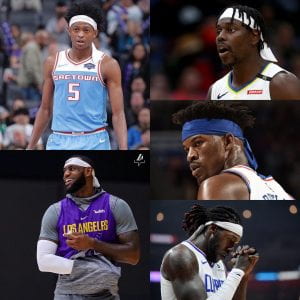October 31, 2019
Being a professional basketball player in the National Basketball Association (NBA), there are many rules and regulations that have to be followed. The NBA is one of the most wealthiest and most known associations in the world. Even though it’s seen as entertainment, for the company and players it’s more as a business. These players sign certain contracts where they make millions of dollars and sign off against certain rules. The NBA and its commissioner Adam Silver has a lot of power and can make some scary decisions. These athletes sometimes like to take matters into their own hands and sometimes do things that the NBA doesn’t like, such as only being able to dress up classy with a suit for courtside games, unable to wear fancy jewelry, and different amount of accessories. If the NBA doesn’t agree or if players don’t follow the rules they can either be fined by the league or suspended for sometime without pay.
Having that type of power can affect a lot of people, and for these players this is their job, most of them players haven’t finished college. Basketball is all they know, they wouldn’t know how to do anything else. Being suspended for sometime usually comes without pay which forces these players to follow the rules even if something doesn’t seem that important. In one case with the NBA, they fined some athletes for not hiding their tattoos. Don’t get me wrong, these players also like to have their voice be heard, so they will speak up when they feel like the NBA is cooperating like they should. The National Basketball Players Association (NBPA), is where players throughout the league are selected to represent the players in their own right. Before the start of the 2019 season, the NBA notified all players the banning of the ninja style headbands, and for many players that rubbed them the wrong way. The NBA’s main reason for banning these headbands were “teams having raised concerns regarding safety and consistency of size, length and how they are tied, which requires a thorough review before consideration of any rule change (Saddler).” Another interesting point, the headbands were made by nike, which is a manufacturer for the NBA, it was a nike product so it didn’t make sense why the NBA forced players not to wear them, Mike Scott said “Who knows why the league has decided to no longer allow these headbands. It’s even more confusing given that Nike is the manufacturer of this particular piece of sartorial flair, and the idea that the NBA would take money out of the hands of its apparel partner is sort of odd (Delgado).” Players right away took to twitter, complaining about how the NBA doesn’t want their players dressing unprofessionally.
This move by the NBA shows them using their power and knowing these players would follow by the rules anyways. This action by the NBA displays the concept of obedience, which is a type of compliance involving acting in accord with a direct order or command, these players had no other choice than to follow the rules. As stated before the players really don’t have any other choice with this ban of headbands for the league, if they continue to wear it, it will eventually lead into fines and suspensions, and with the season just starting no player wants to miss games when they don’t have to. When Milgram brought up obedience, he spoke on different situations. With the NBA they used the concept of legitimacy of authority, these players know the league has all the power in their own future, they know what consequences come with wearing these headbands.
What’s interesting about the decision of banning headbands, the NBA only looks out for themselves as a business and not the benefits of the players. With this action it shows another display of the lowball technique, which is a tactic for getting people to agree to something. People who agree to an initial request will often still comply when the requester ups the ante. Throughout training camp and practice, there was a dress code that allowed these used of headbands, which players felt excited about bringing out new colors and designs on these headbands. When the ban came to light the NBA knew players like “Jimmy Butler, Jrue Holiday, and Mike Scott, had embraced the look but would also feel a certain way with the banning of them (Saddler).” The NBA knew these players in reality wouldn’t fight back because they’re not going to want to lose their job over headbands, but most players felt it was harmless to the game. This gave the NBA an upper hand on these players knowing they still want to be paid and basketball isn’t just a job but a lifestyle to these guys.
Delgado, Dane. “NBA Reportedly Bans Ninja-Style Headbands in 2019-20.” ProBasketballTalk, NBC Sports, 8 Sept. 2019, nba.nbcsports.com/2019/09/08/nba-reportedly-bans-ninja-style-headbands-in-2019-20/.
Brice-Saddler, Michael. “Analysis | An Ode to the NBA’s ‘Ninja-Style’ Headbands: Gone but Not Forgotten.” The Washington Post, WP Company, 12 Sept. 2019, www.washingtonpost.com/sports/2019/09/11/an-ode-nbas-ninja-style-headbands-gone-not-forgotten/.


